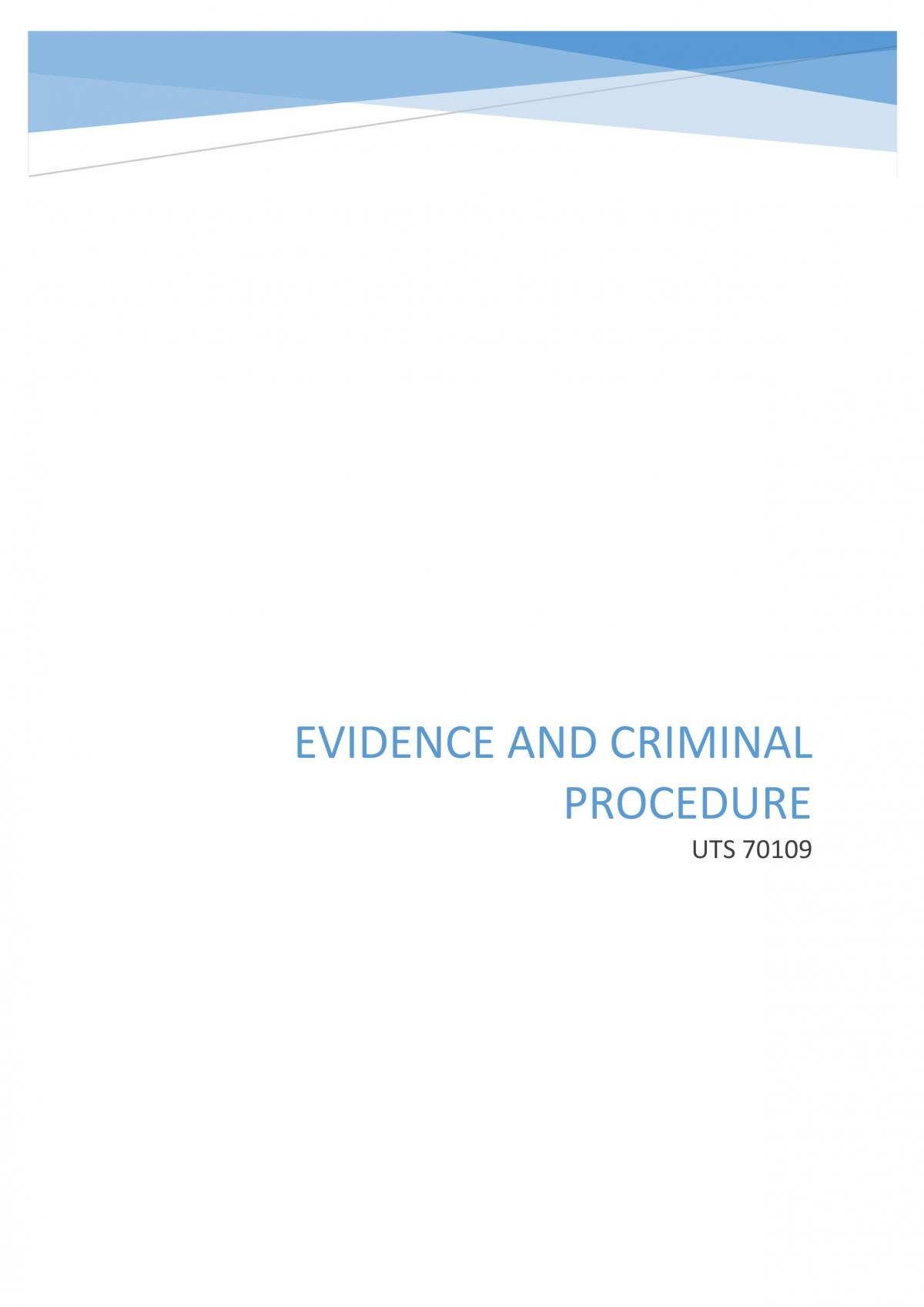Find
Search for over 200,000 study notes and past assignments!
Swap
Download study resources by swapping your own or buying Exchange Credits.
Study
Study from your library anywhere, anytime.
Evidence Complete Set of Notes
70109 - Evidence
93 Pages • Complete Study Notes • Year: Pre-2021
Table of Contents Glossary 5 Approaching Problem Questions 6 Lecture 1: Introduction to Evidence 6 Proof and Presumptions 7 Burden of Proof – Criminal Cases 7 Evidential burden vs Legal burden - TEXT Ch 17 7 Standard of Proof – s 141 8 Standard of Proof – Civil cases 8 Standard of Proof – Criminal cases 8 Judicial Notice 8 Right to Silence will be in exam 8 Pre-trial silence 9 Silence at trial 9 Lecture 2 – Relevance 12 Introduction to the Evidence Act 12 Thresholds to Admissibility 12 EVIDENCE ACT 1995 - SECT 55 Relevant evidence 13 EVIDENCE ACT 1995 - SECT 135 General discretion to exclude evidence 13 EVIDENCE ACT 1995 - SECT 56 Relevant evidence to be admissible 13 EVIDENCE ACT 1995 - SECT 136 General discretion to limit use of evidence 14 EVIDENCE ACT 1995 - SECT 137 Exclusion of prejudicial evidence in criminal proceedings 14 EVIDENCE ACT 1995 - SECT 138 Exclusion of improperly or illegally obtained evidence 14 Relativity of relevance 14 Papakosmas v The Queen [1999] HCA 37 EXAM 15 EVIDENCE ACT 1995 - SECT 66 Hearsay - Exception: criminal proceedings if maker available 15 Papakosmas, per McHugh J 15 Smith v The Queen [2001] HCA 50 16 Evans v The Queen [2007] HCA 59 16 Summary 17 Lecture 3 - Privilege 18 Introduction 18 Client Legal Privilege 18 117 - Definitions 18 Ask: 20 Client Legal Privilege Exam Structure: 20 Professional Confidential Relationship Privilege 22 Religious confessions s127 24 Other privileges 24 Privilege against self-incrimination – s128 25 Lecture 4 – Documents/ Real Evidence/ Witnesses (Competence & Compellability) 26 EVIDENCE ACT 1995 - SECT 11 26 Kinds of evidence 26 PART 2.2 - DOCUMENTS 26 Proof of contents of documents 26 Definition of “document” 26 Section 47(1) of the legislation sets the scope for the rules: 27 Original Document Unavailable: 27 Definition of “unavailable”: Part 2 of the Dictionary: 27 R v Cassar & Sleiman (No 28) [1999] NSWSC 651 27 Section 48 - Proof of contents of documents 28 Real evidence 29 53 Views 29 Cases on Views: 29 Witnesses 30 Calling witnesses 30 Can the judge call a witness? 31 Failure to call witnesses 31 EVIDENCE ACT 1995 - SECT 20 - Comment on failure to give evidence 31 Section 189 The voir dire 31 Section 12 - Competence and compellability 32 21 Sworn evidence to be on oath or affirmation 32 Section 13 - Competence: lack of capacity 32 Section 13(3) - Competence: lack of capacity – Sworn evidence 32 Section13(5)- Competence: Capable of giving unsworn evidence 32 Child witnesses 33 s165A– Warnings in relation to children’s evidence 34 Exceptions to compellability 35 Exam process for Spouse compellability 37 Lecture 5 - Examination of witnesses and Credibility of witnesses 38 Control by the court 38 Seeking leave: S192 - Leave, permission or direction may be given on terms 38 Examination of witnesses - Rules 38 Memory 38 38 Unfavourable witnesses 39 Cross examination s 40-46 39 41 - Improper questions disallow questions 40 The rule in Browne v Dunn 40 43 Prior inconsistent statements of witnesses 40 44 Previous representations of other persons 40 39 Limits on re-examination 41 Credibility of witness 42 Credibility defined - Pt 1 EA Dictionary 42 102 The credibility rule 42 Adam v The Queen (2001) 183 ALR 625 42 s101A (amendment) – Credibility Evidence 43 Using credibility evidence 43 Attacking the credibility of an opposing witness 44 Bolstering the credibility of your own witness 45 Attacking the credibility of your own witness 45 EXAM CHECKLIST 47 Lecture 6: Hearsay – Use of Evidence 48 EVIDENCE ACT 1995 - SECT 59 48 The hearsay rule 48 Hearsay – 3 steps (Simpson J in Vickers v R [2006] NSWCCA 60, [51]) 48 NOTE: Judicial Warning: 48 FIRST: Evidence must be in the nature of a previous representation Definitions 48 SECOND: Previous representation must have been made by a person 49 THIRD: The declarant must have intended to assert the existence of a fact ‘unintended assertions’ 49 Hearsay Exceptions: 50 First hand hearsay Exception 50 Maker unavailable: 63 Civil; 65 Criminal Proceedings (65(8) only applies where accused is giving evidence) 54 What happens to first hand hearsay if maker in unavailable. Unavailability is defined in dictionary. 54 66A Exception: contemporaneous statements about a person’s health etc 55 Documentary exceptions: 55 Lecture 7: Hearsay for a non-hearsay use; Admissions 57 Amended Act: s60 Exception: evidence relevant for a non-hearsay purpose 57 Papakosmas v The Queen (1999) 196 CLR 297 - Evidence can be used for multiple purposes. 57 ALRC Report 102 57 Lee v The Queen (1998) 195 CLR 594 57 Shepherd v R [2011] NSWCCA 245 - Decided under old s60. 59 Admissions 59 s81 Hearsay and opinion rules: exception for admissions and related representations 59 Part 1 Definitions: 60 Admissions: two categories (Inculpatory/ Exculpatory): 60 s89 Evidence of silence 61 89A Evidence of silence in serious indictable offences 61 82 Exclusion of evidence of admissions that is not first-hand 61 Exceptions of admissions: 62 84 Exclusion of admissions influenced by violence and certain other conduct 62 85 Criminal proceedings: reliability of admissions by defendants 62 90 Discretion to exclude admissions 63 Lecture 8: Opinion evidence 65 EVIDENCE ACT 1995 - SECT 76 - The opinion rule 65 Exceptions to s76 65 Lithgow City Council v Jackson [2011] HCA 36 65 Exceptions 67 77 Exception: evidence relevant otherwise than as opinion evidence NOT IN EXAM 67 78 Exception: lay opinions 67 Identification evidence opinions about the identification of people. 68 79 Exception: opinions based on specialised knowledge 68 Amendment: 78A Exception: Aboriginal and Torres Strait Islander traditional laws and customs 68 The Basis Rule 71 S135 and 137 72 Discretionary exclusion of expert evidence: 72 The ultimate issue 72 80 Ultimate issue and common knowledge rules abolished 72 Lecture 9- Tendency and Coincidence 73 95 Use of evidence for other purposes 73 Tendency use? 73 97 The tendency rule 74 ES v R (No1) [2010] NSWCCA 197 74 98 The coincidence rule 75 Common law coincidence cases 75 Coincidence Evidence 6 Points – but need to determine relevance s55 first. 76 Notice 76 “Significant probative value” 76 MUST HAVE SIGNIFICANT PROBATIVE VALUE IN ESTABISHING FACT IN ISSUE 77 Patterns of behaviour 78 Jacara v Perpetual Trustees (2000) 106 FCR 51 78 Another step for evidence – only applies to prosecution in criminal trials 78 101 Further restrictions on tendency evidence and coincidence evidence adduced by prosecution 78 At common law 78 Under the Evidence Act 79 Lecture 10 – Exclusion of Evidence Warnings, Comments & Directions 81 135 General discretion to exclude evidence 81 s135(a) – unfairly prejudicial 81 s135(b) – misleading or confusing 82 s135(c) – undue waste of time 82 137 Exclusion of prejudicial evidence in criminal proceedings 82 R v Linard Shamouil [2006] NSWCCA 112 82 R v Keenan Mundine [2008] NSWCCA 55 83 138 Exclusion of improperly or illegally obtained evidence 83 139 Cautioning of persons 83 136 General discretion to limit use of evidence 84 Judicial directions, comments & warnings 85 Judicial comments 85 Judicial warnings 86 165B Delay in prosecution (Amended Act) 87 Delayed complaints 87 Lecture 11 – Revision: 88 What is the form of the evidence? 88 Witnesses 88 Credibility 89 Documentary evidence 89 Real evidence (other evidence) 89 Is it privileged? 90 Is it admissible? 90 Once the evidence has been admitted… 93 Evidence Act 93
This document is 25 Exchange Credits
More about this document:
|
|
This document has been hand checkedEvery document on Thinkswap has been carefully hand checked to make sure it's correctly described and categorised. No more browsing through piles of irrelevant study resources. |
|
|
This is a Complete Set of Study NotesComplete Study Notes typically cover at least half a semester’s content or several topics in greater depth. They are typically greater than 20 pages in length and go into more detail when covering topics. |
|
|
What are Exchange Credits?Exchange Credits represent the worth of each document on Thinkswap. In exchange for uploading documents you will receive Exchange Credits. These credits can then be used to download other documents for free. |
|
|
Satisfaction GuaranteeWe want you to be satisfied with your learning, that’s why all documents on Thinkswap are covered by our Satisfaction Guarantee. If a document is not of an acceptable quality or the document was incorrectly described or categorised, we will provide a full refund of Exchange Credits so that you can get another document. For more information please read Thinkswap's Satisfaction Guarantee. |

Studying with Academic Integrity
Studying from past student work is an amazing way to learn and research, however you must always act with academic integrity.
This document is the prior work of another student. Thinkswap has partnered with Turnitin to ensure students cannot copy directly from our resources. Understand how to responsibly use this work by visiting ‘Using Thinkswap resources correctly’.
Browse UTS Subjects









